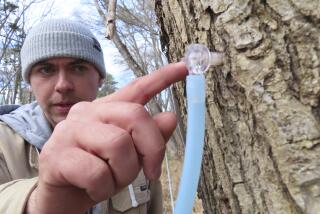Scientists create ‘designer chromosome’ in brewer’s yeast
Scientists say they have created a “designer chromosome” in brewer’s yeast that will mutate on command.
In a study published this week in Science, researchers said they had successfully “synthesized” one of the 16 chromosomes in Saccharomyces cerevisiae -- a workhorse fungi that is used in myriad industrial processes, including making bread, brewing beer, producing biofuel and manufacturing vaccines.
“We have a yeast that looks, smells and behaves like a regular yeast, but this yeast is endowed with properties normal yeast don’t have,” said lead study scientist Jef Boeke, director of the NYU Langone Medical Center’s Institute for Systems Genetics.
The seven-year effort is part of a much larger project to develop a yeast cell with an entirely human-designed genome, Boeke, said.
Scientists have already transplanted a synthetic genome into a bacterium, but yeast cells are a little more more complicated. They are eukaryotes, meaning they have a cell nucleus, and they also have 16 chromosomes instead of bacteria’s one ring-shaped chromosome.
Boeke and his colleagues hope to be the first researchers to implant a complete synthetic genome -- or all 16 chromosomes -- into a yeast cell, a project they have dubbed Sc2.0.
In this week’s paper, researchers focused on S. cerevisiae’s chromosome III -- one of its smallest -- and redesigned it on a computer.
The researchers mirrored much of the cell’s natural chromosome but dispensed with sections of so-called junk DNA -- regions of DNA between genes that appear not to have a purpose or are repetitive.
Chromosome designers also removed “jumping genes,” genes that change positions between generations and cause mutations. Instead, they added their own genetic sequences that would cut and rearrange DNA if the cells were exposed to the chemical hormone estradiol.
By doing this, Boeke said, researchers could control precisely when the yeast cell would experience mutations, essentially controlling the organism’s evolution by causing “its genome to rearrange in millions of different ways on command.”
Once they had their design, Boeke and an international team of scientists, plus undergraduate students at Johns Hopkins University, assembled the synthetic genome by stitching together strings of nucleotides -- the four basic building blocks of DNA.
Researchers then took these DNA strings, which make up individual genes or sets of genes, and used them to replace existing genes, a methodical process. Study authors said this splicing occurred over 11 successive rounds of chromosome “transformation.”
Ultimately, researchers hope their ability to scramble S. cerevisiae genes will result in controlled evolutionary changes that may aid industrial processes. Boeke said it will also help to teach scientists about biology.







